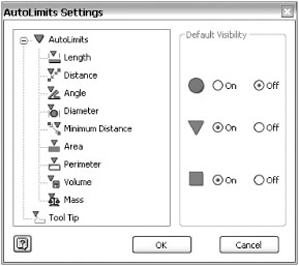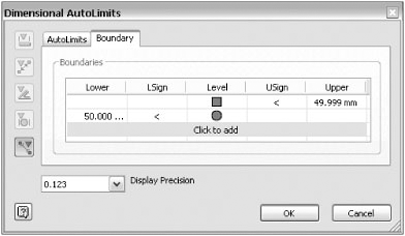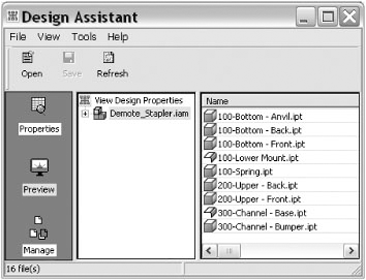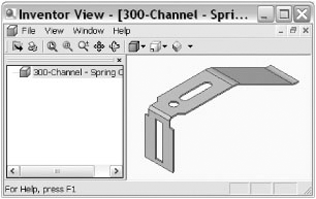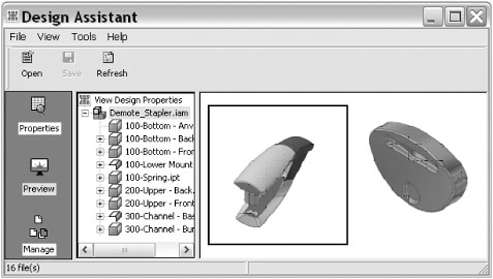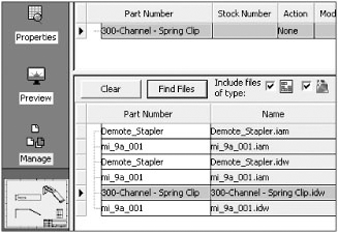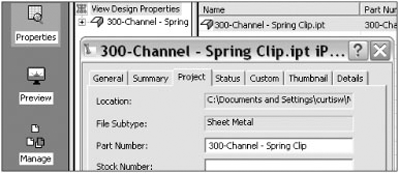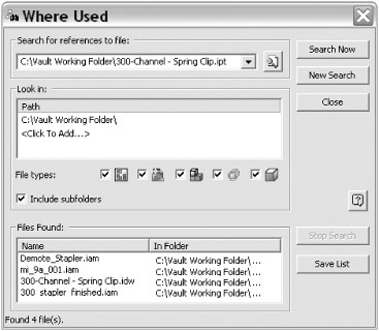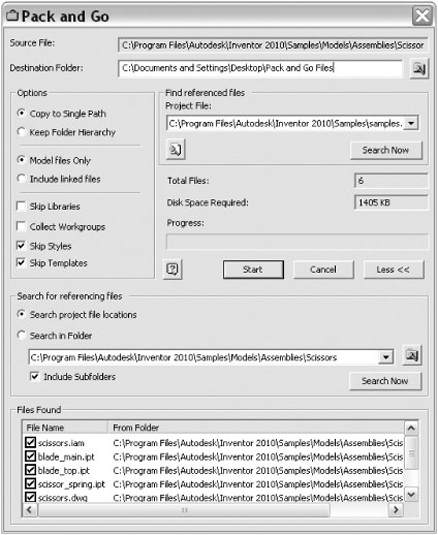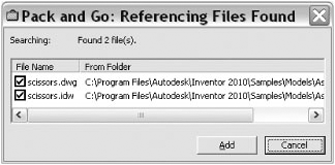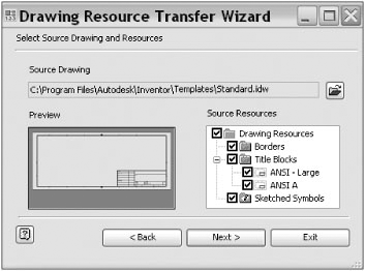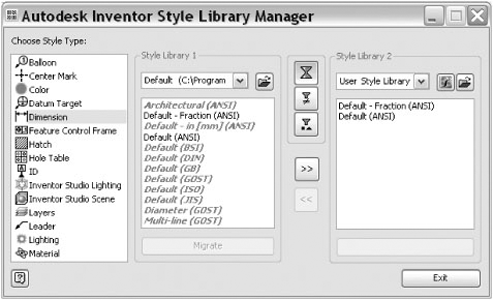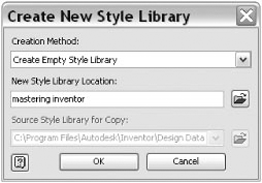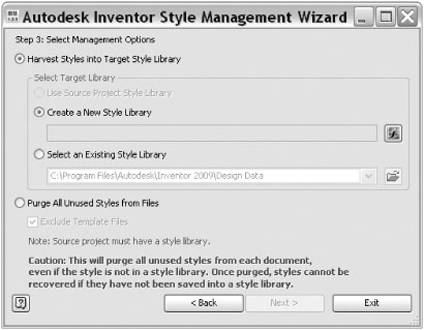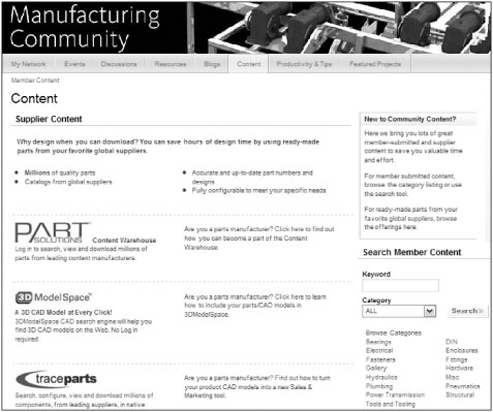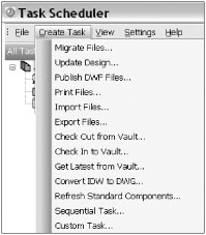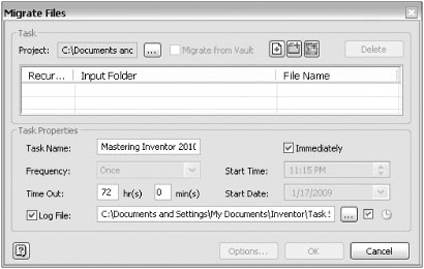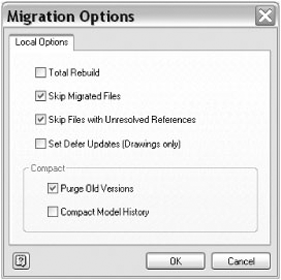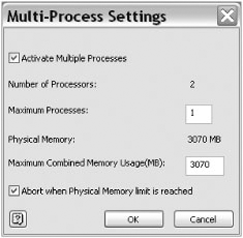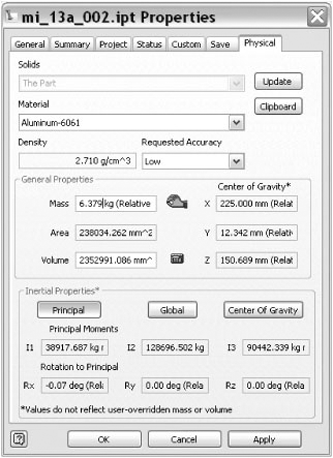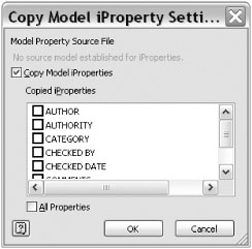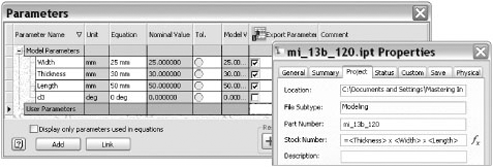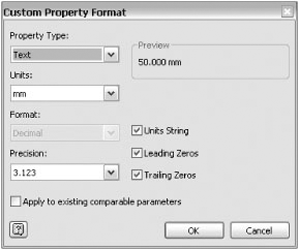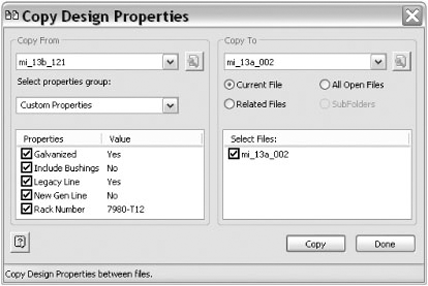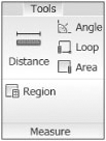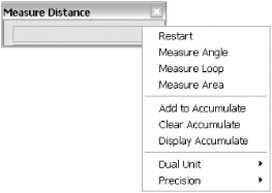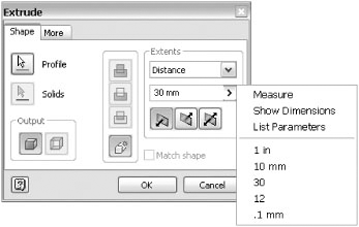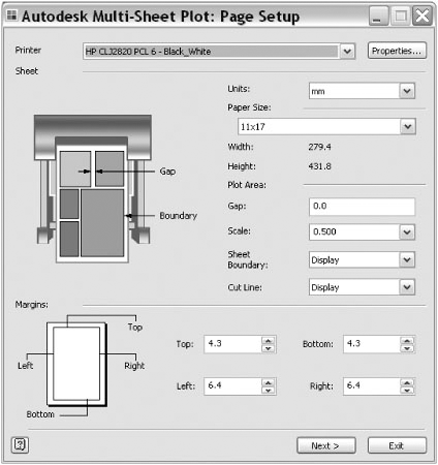Using tools effectively helps you improve your productivity and get the most out of Autodesk Inventor. Initially, tools require a certain amount of familiarity to be productive; however, they pay off in the long run.
This chapter assumes you have a good understanding of parts, assemblies, and drawings. In this chapter, you will learn the various aspects of Inventor tools and some of the add-ins that are helpful. We will cover the key aspects of the tools and add-ins that come with Autodesk Inventor and some relevant workflows. Many other tools that are built using the Autodesk Inventor application programming interface (which is not covered in this book) are available on myriad websites. We will cover various topics in this chapter, including the AEC Exchange, AutoLimits, Design Assistant, Drawing Resource Transfer Wizard, style tools, Supplier Content Center, Task Scheduler, the iProperties tool, the Measure tool, the CIP, CER, and more.
In this chapter, you'll learn to:
Take your models from Inventor to Autodesk Building Systems
Create AutoLimits (design sensors)
Manage design data efficiently using Inventor tools
Manage styles
Create expressions with iProperties
Measure in assemblies
Give feedback to Autodesk
The Architecture, Engineering, and Construction (AEC) Exchange is an add-in environment for parts and assemblies. Using the AEC Exchange, you can import Inventor models into Autodesk Building Systems (ABS), which is another Autodesk product used for building design and construction systems. ABS is used to document the architectural, mechanical, electrical, and plumbing information of designs. To access the AEC Exchange environment, select the Environments tab and click EC Exchange while in a part or an assembly.
Typically, when you author an Inventor model for use with an ABS application, you will want to reduce the amount of detail in that model so that the file size is smaller and so that you are not giving away too much intellectual property. You start with a part or assembly file and use either a simplified or shrink-wrap level of detail (LOD) representation to remove unneeded detail from your model.
You can do this by following these steps:
The shrink-wrap part file is created, and you are returned to the source assembly. In the assembly, the shrink-wrap will be the active LOD. Now you are ready to author the model for the AEC Exchange. See Chapters 8 and 9 for more detailed information on LOD representations.
The AEC Exchange environment allows you to create connector objects such as cables, conduits, ducts, and pipes on the simplified model. These connector objects define the interfaces, which are the connection points between Inventor and the AEC model. Autodesk Inventor allows you to create, edit, and delete connector objects. Here are the steps to create a conduit connector:
On the Get Started tab, click Open.
Browse for the file named
mi_13a_444.iptlocated in the Chapter 13 directory of the Mastering Inventor 2010 folder, and click Open.Select the Environments tab, and click AEC Exchange.
On the Exchange tab, click the Conduit Connector icon.
In the Conduit Connector dialog box, select Circle as the shape for the connector (using Undefined allows the selection of any oval, circular, or rectangular face).
Select the yellow circular face to place the connector. The location of the connector appears as a cylindrical arrow. Click the direction button to reverse the connector direction.
Clear the check box next to the size field, and enter a value. Or leave the box selected to have the value linked to the model.
In the Connection Type drop-down menu, select Threaded.
Click Apply to continue to add connectors, or click OK to create the connector and close the dialog box.
Add a pipe connector to the blue circular face and a duct connector to the top red rectangular face. Explore the options, and author these connectors with values of your choosing.
Save the file.
A part in the AEC Exchange is the basic unit, that is, a specific size of the component placed within a part family. The part has instance-specific properties associated with it, for example, a name and geometric representation. Use the Export Building Components tool to save model geometry, properties, and connectors to an Autodesk Exchange File (*.adsk) file. An *.adsk file can be read by programs such as Revit MEP and AutoCAD MEP (note that earlier versions of Revit and AutoCAD MEP may not support the *.adsk file format).
For programs that do not currently read the *.adsk file format, such as standard AutoCAD, use the Save AS DWG Solids tool on the AEC's Ribbon to save an active Inventor model as a base solid *.dwg file. You can open this solid in any AutoCAD or Revit program that will read a 3D *.dwg and then use it to ensure fit and placement. Note that there is no connector or property data attached to it. It may be important to know that the resulting solid is initially contained in a block definition. Follow these steps to publish a model in the AEC Exchange tools:
On the Get Started tab, click Open.
Browse for the file named
mi_13a_445.iptlocated in the Chapter 13 directory of the Mastering Inventor 2010 folder, and click Open.Choose the Environments tab, and then click AEC Exchange. Note the connectors have been authored already. Do not be too concerned that this exercise model is not realistic in its configuration, because its purpose is merely to demonstrate the available tools.
Click the UCS tool in the AEC Exchange tab to define a new user coordinate system.
Specify the origin by choosing the vertex at the corner indicated with the black arrow.
Specify the x- and y-axes by choosing the vertices on the edges indicated with the black X and Y.
Notice the new UCS node in the browser. You can rename it by clicking it twice slowly.
Next click the Check Design icon, and notice that there are some yellow warning icons indicating missing information.
Click OK.
Click the Export Building Components icon.
To set the component type, click the Browse button.
Choose the following from the drop-down menu:
23.75.00.00 Climate Control (HVAC)
23.75.70.00 HVAC Distribution Devices
23.75.70.17 Water Heated and Cooled
23.75.70.17.37 Unit Heaters
Click OK.
Enter the following information in the Component Properties area. Notice that the Cost field text turns blue to indicate that it does not match the iProperty. This allows you to enter property overrides and still be aware of which are overrides and which are pulled from the model. All iProperty fields have a cyan colored background.
Model: 12345-6T
Cost: 990.01
Choose a user UCS from the Named UCS drop-down.
Click the Check Design button, and note that all the yellow warning icons are now gone.
Click OK.
Click OK in the Export Building Components dialog box to save an
*.adskfile (you can click Cancel and choose not to save this file if you'd like).
The AutoLimits tool allows you to monitor model changes so that you can reduce errors and engineering changes. You can think of it as a sensor. For example, say you are a plastics manufacturer and want to analyze the situation when the wall thickness of the components becomes too thin, or perhaps you are a machinist and want to know when two holes come too close to one another. You want to define this "check" and ensure that such a situation is caught early in the design. With AutoLimits, you can set up these limits and let the system warn you. The AutoLimits that you create with the tool are passive and hence do not drive geometry or stop a feature from violating a limit. They simply notify you when it does. Another way to look at the AutoLimits tool is as a persistent measure tool. The standard Measure tool performs the measurement and the result does not persist, while with the AutoLimits tool the measurement persists. When you open a file, the AutoLimits you have created are not shown unless you activate the AutoLimits panel bar.
The AutoLimits tool monitors the following limits:
Figure 13.1 shows the AutoLimits tool icons as accessed from the AutoLimits panel of the Analysis tab.
Feedback is given to the user in terms of shape and color. For example:
A green circle means it is within the boundary limit.
A yellow inverted triangle means it is near the boundary limit.
A red square means it is beyond the limit.
Figure 13.2 shows the different types of AutoLimits and their settings. (Click the AutoLimits Settings icon shown in Figure 13.1 to access this dialog box.) You can control the visibility of each AutoLimit type by using the On and Off radio buttons shown. In an assembly, only the edited document's AutoLimits are visible in the browser; in other words, AutoLimits at subassembly levels are not visible or available unless that subassembly is edited.
To see AutoLimits in action, follow these steps:
On the Get Started tab, click Open.
Browse for the file named
mi_13a_002.iptlocated in the Chapter 13 directory of the Mastering Inventor 2010 folder, and click Open.On the Inspect tab, click AutoLimits Settings button and ensure that all three Default Visibility options are set to on, and then click OK.
This part has a layout sketch upon which the solid was based. The length has been left underdefined by creating the visible driven dimension. Two AutoLimits have been added. The first alerts you if the distance from the front edge to the rectangular cut becomes too thin, and the second alerts you if the mass of the part becomes too heavy. To adjust the model, follow these steps:
Click the sketched point or construction line, and drag it in or out.
Then use the Update button

Drag the sketch point out so that the visible dimension is around 470, and click the Update button. Note the red square in the middle of the part. This is the Mass AutoLimit, indicating that current length causes the part to be too heavy.
Drag the sketch point in so that the visible dimension is less than 300, and click the Update button. Note the red square on the edge of the part; this is a lower limit, Length AutoLimit, indicating that current overall length causes the width between the rectangular cut and the edge of the part to become too thin.
AutoLimits come in three types: Dimensional, Area-Perimeter, and Physical Properties. In the following steps, you'll create a Minimum Distance limit and then define the limit boundaries:
On the Get Started tab, click Open.
Browse for the file named
mi_13a_003.iptlocated in the Chapter 13 directory of the Mastering Inventor 2010 folder, and click Open.On the Inspect tab, click the AutoLimits Settings icon.
Set all three default settings to On, and click OK.
Click the Dimensional icon in the AutoLimits panel.
On the left of the dialog box, click the Minimum Distance AutoLimit icon (the last one on the bottom).
For the selections, you can click the edges with work axes running through them, or you can click the axes (the axes are not required and have been placed just to help identify the correct edges).
Click the Boundary tab.
Click the Click To Add bar to place the green "okay" AutoLimit.
Set the Lower value to 50mm.
Rather than setting an Upper value, you will change the Usign column so that the Upper limit is open ended. Click the < under Usign, and choose the blank or empty entry from the drop-down.
Next you want to add another row to define the lower limits. To do this, hold down the Ctrl key, and click the Click To Add bar. The new row should appear above the previous row in the table.
Click the yellow triangle twice slowly in the Level column, and change it to the red square in the drop-down.
Set the Upper value to 49.999mm.
Change the Lsign column so that the lower limit is open ended. Click the < under Usign, and choose the blank or empty entry from the drop-down. Your boundary should resemble Figure 13.3.
Click OK, and then click OK in the message dialog box.
You should see a green dot appear on your model; this is your AutoLimit.
Double-click the Length dimension, and change the value to 299mm.
Click the Update button

Change the Length Dimension to 300mm, and click Update. Note the AutoLimit displays a gray X. This indicates that there is a gap in the AutoLimit.
Hover your mouse pointer over the gray X until it changes color; then right-click and choose Edit AutoLimits.
Click the Boundary tab.
Select the Lower limit for the green row, change 50mm to 49.9999mm, and then click any other cell. Note it sets the value back to 50.000mm.
Click OK to return to the model, and note the Autolimit is now green, as shown in Figure 13.4.
You can view all the existing AutoLimits in your model by clicking the white arrow on the browser bar and changing from the Model browser to the AutoLimits browser. You can edit AutoLimits in the AutoLimits browser by selecting each AutoLimits entry and right-clicking it. It is recommended you set the selection filter to Feature Priority, because it will be easier to select the AutoLimits glyphs. You can copy or delete AutoLimits by right-clicking them in the browser. You can also create a group of AutoLimits to control the visibility of related AutoLimits. To do this, follow these steps:
Right-click the top node in the AutoLimits browser, and select Create Group.
Right-click any AutoLimit, and choose Copy AutoLimit.
Right-click the group, and choose Paste AutoLimit.
Now you can right-click the group to toggle visibility.
The Design Assistant helps you find, manage, and maintain Autodesk Inventor files and related documents, spreadsheets, and text files. Imagine your company is evaluating a new design that involves doing minor changes to an existing design. You would like to reuse the parts, assemblies, drawings, and presentations as much as possible. Once you make the required changes and finish the new design work, you need to send the existing and modified designs to another department for their input on the overall design. The Design Assistant (DA) and Pack And Go tools can help in this situation. Based on file relationships, you can perform searches, create file reports, and work with links across Inventor files. In addition, you can preview and view the iProperties.
You can launch the DA in three ways:
Within Inventor, click the Inventor button

Right-click a file in Windows Explorer, and select the Design Assistant tool.
Select Start

The Design Assistant dialog box, as shown in Figure 13.5, contains three buttons in the left column: Properties, Preview, and Manage. You can open files using the File
You can right-click any file in the DA and select View in Inventor View 1.0, which launches the Inventor View dialog box, as shown in Figure 13.6. In the Inventor View dialog box, you can use the view functions such as Zoom, Pan, and Rotate.
To view the preview in the DA, you can click the Preview button in the Design Assistant dialog box too, as shown in Figure 13.6. The DA shows the preview for all the files. Figure 13.7 shows the preview of the top-level assembly and one of the parts contained in the assembly. You can choose any listed file to display its preview.
You can use the Find Files tool to locate all references to a specified file. This can be very useful when trying to determine how an edit, revision, or change order will affect existing designs. To use the Find Files tool, follow these steps:
Click the Manage button in the left column, as shown in Figure 13.8.
Click the Drawings, Assemblies, and Parts check boxes. These check boxes are located next to the text Include Files Of Type in the Design Assistant dialog box.
You can check Search Subfolders shown next to the Parts check box in the Design Assistant dialog box to include subfolders.
Find Files will find the files that use the selected file. In Figure 13.8,
300-Channel - Spring Clip.ipthas been selected, and the referencing files found are listed in the bottom pane.
Right-clicking a file and selecting iProperties gives you the properties for the selected part or assembly without opening the part or assembly in Inventor, as shown in Figure 13.9. Note you do this after clicking the Properties or Preview button; the iProperty option is not available from Manage view.
Selecting Tools
In the Path area under Look In, you can add paths that you want to search. The Where Used tool will list all the files where the specified file is used in some way. File relationships can include but are not limited to derived components and using a part or assembly in an assembly, drawing, presentation, and so on. Figure 13.11 shows a Where Used search run using the Design Assistant on a file in the local Vault workspace. However, the Design Assistant is often used without Vault.
You can use the DA to perform management tasks such as renaming, copying, and replacing Inventor files without breaking the links to the files that reference them. This is because DA not only performs the management task on the files but also "cracks" the referencing files and updates the link to the file at the same time. This is the fundamental difference in doing these operations in Windows Explorer (not recommended) and doing them in the DA.
To rename a file that is in an assembly, drawing, or presentation, follow these steps:
Close Inventor.
Open the assembly, drawing, or presentation file in the Design Assistant.
Click the Manage button. In the Manage browser, click to select the component to be renamed. Right-click in the Action column, and select Rename. All occurrences of the component are highlighted.
Right-click the Name column, and select Change Name. In the Open dialog box, change the name, and select Open (you're not really opening anything; you are just setting the name).
Click Save to apply the changes.
To copy a file that is in an assembly, drawing, or presentation, follow these steps:
Close Inventor.
Open the file in the Design Assistant.
Click the Manage button. In the Manage browser, click to select the component to be renamed. Right-click in the Action column, and select Copy. All occurrences of the component are highlighted.
Right-click the Name column, and select Change Name. In the Open dialog box, enter the name of the new copy, and select Open (you're not really opening anything; you are just setting the name).
Repeat steps 3 and 4 for all the files you want to copy. For instance, if you are copying a drawing and the part that this drawing details, you would complete steps 3 and 4 for both the drawing and the part.
Click Save to create the copies. Your copies will be created right next to the original files.
This can be incredibly useful when you want to create a copy of an existing detailed design so that you can make changes to the copy. Create the copy of the drawing(s) and the components and then make the changes.
If you want to replace a part or assembly file with an assembly, you can right-click the Action cell and then select Replace. Right-click the Name cell for the component, and then click Change Name. In the dialog box, select the replacement file. After a file is replaced, renamed, or copied, other files that reference the original file need an update. The Update option will be useful, as shown here:
Open the assembly file in the Design Assistant.
Click Manage, and select files that are being modified from the upper browser.
In the lower browser, select the file types you want to include in the update.
Click Find Files. The referencing files are displayed in the lower browser.
In the lower browser, select the file types you want to include in the update.
Click the Save button to apply the changes.
The Design Assistant cannot make changes in certain circumstances. Examples are when the active project is set to semi-isolated, when the design state of a file is set to released, when read-only permissions are set, when trying to change the workgroup copy of the file, and so on.
You can use the Pack And Go tool to package an Autodesk Inventor file and the set of referenced Inventor files in a project or folder to a single location. This is a useful feature to typically archive a design and all the files related to the design into a single ZIP file. For example, if you had the following assembly:
Assembly1.iamPart1.iptPart2.iptPart3.ipt
the problem is you are not sure what directories the part files are in. Pack And Go can find all the parts for Assembly1.iam and copy them into a new directory. You can then zip the files in that new directory to be archived or sent to other users. You can access the Pack And Go tool by right-clicking in Microsoft Windows Explorer or from a Design Assistant session started outside Inventor. Click the Properties or Preview tab, and right-click the Assembly to access the Pack And Go tool.
To use Pack And Go on an assembly, follow these steps:
Click the Application button and choose Save As

Set the destination directory to the folder where you want to copy the files.
If you have multiple project files, use the Browse button to ensure you are looking at the proper one.
Click the More button to expand more Pack And Go options, as shown in Figure 13.12.
Click Search Now to find the IPT and IAM files that are referenced by the assembly file. They will appear in the Files Found section at the bottom of the dialog box.
This finds all the files referenced by the assembly file, but what if you know that the assembly and part files had drawings detailing them? To search for referencing files, click the Search Now button in the Search For Referencing Files area.
If files are found, you can select which ones to add and then click the Add button. Note that there is no progress bar in this dialog box, so you have to watch the top of the dialog box and wait for "Found # file(s)" to appear to know that it is done, as shown in Figure 13.13.
Click the Start button to start the copying process. Once the files are copied, the Cancel button turns into a Done button to let you know.
Typically you will want to configure some of the options because these will yield different Pack And Go results. Here is a description of each:
- Copy To Single Path
Copies the referenced files to a single folder, reducing folder hierarchies. If any files have the same filename, only one of the files can be placed at the destination folder.
- Keep Folder Hierarchy
Preserves the folder hierarchy under the destination folder. Use this option for round-trip file transfers such as sending files to a contract worker or customer or when you are packing files to work on a laptop while offsite. Maintaining the folder hierarchy will allow you to move the files back to the original destination smoothly when they return.
- Model Files Only
Copies only Inventor files (
.iam,.ipt,.idw,.dwg, and.ipn) to the destination folder. Referenced files such as spreadsheets, embedded pictures, and text files are not copied.- Include Linked Files
Includes referenced files such as spreadsheets, embedded pictures, and text files.
- Skip Libraries
When selected, all files found in a library path such as Content Center files and user-defined library files are excluded from the Pack And Go tool.
- Collect workgroups
If selected, workgroups and the workspace are collected into a single folder. This is typically relevant only when working with a legacy project type.
- Skip Styles
If selected, style XML files are not copied with the packaged file.
- Skip Templates
Templates are not copied with the Pack And Go files, when this option is selected. You can generally use this option and deselect it only for special circumstances.
It is important to note that Pack And Go does not modify the source files. When you package Inventor files, they are copied to the new destination. A log file and a copy of the original project file with a .txt suffix are also copied to the destination folder. Changes made to the packaged files do not affect source files.
Uses of Pack And Go include the following:
Archiving so that you can package files on a CD-ROM.
Sending files to another user.
Separating the referenced files from other files in the same source folders.
Copying an assembly to a new location and then creating a design variant by making changes to the copy. The original is unaffected.
Pack And Go uses the active project file. You can change the active project file. If you have files in multiple locations, the project file must specify all those locations.
The Drawing Resource Transfer Wizard helps copy drawing resources such as borders, title blocks, and sketched symbols from one source drawing to one or more destination drawings. To use the tool, you have to close Autodesk Inventor just to avoid a situation where you are in the middle of modifying a drawing and you want to use that drawing as part of the process for transferring resources.
For example, imagine your company has hundreds of drawings in Inventor. However, there has been a change in the standard note that is on every drawing. If the standard note was created as a sketched symbol, then this update can be batched. The transfer wizard is an ideal solution to solve this kind of problem.
Follow these steps to use the wizard:
Select Start

On the welcome screen, click Next.
On the Select Source Drawing And Resources screen, select the drawing template, and then click OK.
This loads the preview (if available) under Preview and shows the available drawing resources hierarchy in the source under Source Resources. You can deselect the resources you don't want to transfer to destination, as shown in Figure 13.14.
Click Next to go to the Select Target Drawings screen. On this page, select one or more drawings (with Shift-select), and click Open. You can click the file or path column name to sort files.
Click Next, and select Yes or No for replacing resources in the target file with the same name as in the source. Selecting Yes means using the same name as the source for the target file. Selecting No means give a unique name to target drawing resources that have the same name as those in the source file. For instance, instead of writing over a title block definition named TB_100, you would end up with TB_100 and Copy of TB_100 in your files.
Click Start, which shows the progress bar and a Pause button to temporarily halt the process.
When done, click Exit to complete the process.
If you have a number of old drawings that you need to bring up-to-date with a new standard, this tool is very useful.
Two helpful Style tools that are external to Autodesk Inventor are the Style Library Manager and the Style Management Wizard. Both can be used to manage style libraries in your template files. You should consider using these tools when attempting to remove unwanted styles from templates. You can access them both by selecting Start
You can use this tool to copy, rename, and delete style libraries. For example, imagine you are a CAD administrator who rolls out all the standards for your company, and you want to ensure that a good library of styles exists for others to use. The Style Library Manager comes to the rescue in this situation. You can create a new style library using the Create New Style Library button, as shown in Figure 13.15 under the Style Library 2 column. Figure 13.15 shows the dialog box for the Style Library Manager. Any changes in the style library are not available in other documents until Autodesk Inventor closes and a new session is reopened.
You can reuse your styles by copying them from one style library to another by following these steps:
Click the Style Library Manager tool.
In Style Library 1, click the drop-down arrow to select the source library styles you want to copy, or use the Browse button.
In Style Library 2, you have three options:
Copy an existing style library.
Create an empty style library.
Use the Create New Style Library button to select the last two options, and use the Browse button to use the first. Figure 13.16 shows a new empty library being created.
Click one or more styles in Style Library 1, and then click the >> button to add them to Style Library 2. Click the arrow buttons to add or remove styles to the destination as desired.
Creating a new empty library and then bringing in approved styles one at a time is the best way to ensure that you a get a clean styles library with only the styles that you want and nothing else.
In Style Library 1 or 2, you can right-click a style name and select Rename or Delete. A warning will appear that all document links to that style will be broken or the style will be permanently deleted from the style library. Click Yes to continue, and enter a new name. Click No to cancel the Rename or Delete operation. Note that you cannot undo or reverse a deletion.
Changes are saved as you make them. Once all changes have been made, click the Exit button.
This wizard helps you go through a set of Inventor files (parts, assemblies, and drawings), collect all the style definitions within those files, and write them into a new library or append them to an existing style library. Prior to Autodesk Inventor 9, all styles were stored locally in documents. The key point is that this tool helps you collect the scattered styles into one central repository. Your Inventor files need to be migrated to the current release before using this tool. You can harvest dimensions and text styles directly from your AutoCAD DWG files too. This helps you roll the changes to multiple files in one operation.
The source is a group of Inventor files such as parts, assemblies, and drawings, and the destination is a style library. Harvesting styles means you can collect all the styles from these source files and add them to the target style library.
To harvest styles, follow these steps:
Select Start

On the welcome screen, click Next.
Specify the project to use, and click Next.
Add files using one these methods:
Select a project and add all its files (by clicking the Add All Files In Active Project button).
Select and add individual files (by clicking the Add Specific Files button).
Drag and drop files from Windows Explorer into the Style Management Wizard.
Add a top-level assembly or drawing, and then right-click it in the Style Management Wizard and select Get Referenced Files.
Add a top-level assembly or drawing, and then right-click it in the Style Management Wizard and select which files to get, as shown in Figure 13.17.
Once files are added, you can click the column headings to sort like you do in Windows Explorer. Click Next once all files have been added.
In the Management Options area, click Harvest Styles Into Target Style Library. You can then select the target library by one of these methods, as shown in Figure 13.18:
Use Source Project Style Library, if applicable, automatically selects the style library specified in the project.
Create a new style library by clicking the Create A New Style Library radio button and then clicking the Create New Style Library button to specify the name and location.
Select an existing style library by selecting the Select An Existing Style Library radio button and then choosing the library from the drop-down or by using the Browse button.
Once you've set the management options, click Next.
Review the selections you have made, and then click Start to begin the process.
A log file is generated during processing, and you can halt the process by clicking Pause. You can also click Cancel to stop.
In large files (assemblies), it becomes imperative to keep only the styles that are used. Oftentimes because you have used template files to house your styles originally, you might have an abundance of unnecessary styles in each and every file. Having extra material and color styles in each part may not be an issue for small assemblies, but when you think about all the extra overhead that these styles add for assemblies with part counts of 1,000 or more, you can begin to realize that it is significant. For drawing files, extra styles can contribute to slow load times, as well as mistakes created by accidentally selecting the wrong dimension style, and so on.
To remove unused styles, you can specify a group of files such as parts, assemblies, and drawings and remove every unused style in all the documents. This technique is used to remove styles from legacy documents that now use a style library. It is recommended that you back up the styles before you do this operation since the involved styles are permanently deleted. You can use similar steps as in harvest styles to process the files. The major difference for Purge Styles From Harvest Styles is that in step 5 of the previous section, you select Purge All Unused Styles From Files.
You can access the Supplier Content Center in the following ways:
Go to
www.autodesk.com/suppliercontent.From within Inventor, with no files open, click the Supplier Content icon on the Tools tab.
Select Start

Figure 13.19 shows the Supplier Content Center web page.
The main advantages of using the Supplier Content Center are the following:
The Supplier Content Center promotes design reuse.
The Supplier Content Center supplies Autodesk Inventor native data: parts or 2D views. Also available are Mechanical Desktop and AutoCAD parts and assemblies from commercial suppliers.
The Supplier Content Center ensures that part numbers and metadata are accurate, and it makes ordering easy and accurate.
The Supplier Content Center provides reconfigurable parts and assemblies to meet your custom needs.
The Supplier Content Center keeps parts up-to-date.
These parts are available in native Autodesk Inventor format from more than 100 suppliers. Some supplier contents are listed here:
Part solutions
3D model space
Traceparts
On the Supplier Content Center website, you can browse the information by category such as Bearings, Fasteners, Hydraulics, and so on. You have to log in to download parts and reuse them. You can also do a keyword search and select the category.
To use parts and assemblies from the Autodesk Supplier Content Center, follow these steps:
Go to the Supplier Content Center website, and create an account.
Log in with a username and password.
Under Settings, click the CAD format you need; it will show parts in this format.
Search and navigate the catalogs for the desired part. Configure the part or assembly. You can click the eye icon to preview a part.
Add the part to My Documents by clicking the shopping cart icon.
Download the part by clicking the disk icon.
Click the download icon after the generation of the part is finished to save it.
A large design repository needs to have a way to manage tasks for efficiency and repeatability. Nonproductive and mundane tasks tend to be expensive and tedious. The purpose of the Task Scheduler is to precisely automate such tasks. To access the Task Scheduler, select Start
Imagine you are working for a service company that handles outsourcing work for auto suppliers. The supplier works with hundreds of files. The supplier is trying to decide whether to move to Inventor 2010. You have been asked to evaluate this for the supplier. You want to do testing and present quantitative data on the results of migration or some other custom tasks the supplier normally performs on legacy files. The main purpose of the Task Scheduler is to automate the tasks and quickly give you results. The Task Scheduler has the ability to create various tasks such as the following:
Migrating a set of files from AutoCAD, Autodesk Mechanical Desktop, and Autodesk Inventor software
Converting Inventor IDWs to Inventor DWGs
Publishing DWF files
Importing files and exporting files
Checking out and checking in from Vault
Printing sheet sets
Running a custom macro (such as a Visual Basic routine)
To create a task to migrate files in Task Scheduler, follow these steps:
Open the Task Scheduler by selecting Start

Select Create Task

In the Migrate Files dialog box (see Figure 13.21), enter the task name, frequency, start time, and start date. If Immediately is checked, the task will start immediately after you click OK. The log file helps to see the output of the task.
Use one of the three buttons along the top to add files in one of the following ways:
- Add Files
Select files from the active project to add to the task.
- Add Folder
Browse to a folder or folders to add to the task. Use the File Name drop-down to select which file type to process. Ensure the Recursive check box is selected to include subfolders.
- Add Project
Select a project to include all files in that project search paths.
Click the Options button to open the Migration Options dialog box like the one shown in Figure 13.22. The options are also listed here:
- Total Rebuild
Rebuilds all the parts and assemblies.
- Skip Migrated Files
Ignores files created in the current version or files already migrated.
- Skip Files with Unresolved References
Ignores files with broken links and references.
- Set Defer Updates (Drawings Only)
Toggles on the setting that allows drawings to be made static so that they do not update as the part or assembly they detail updates. This can be toggled off manually from the drawing later.
- Purge Old Versions
Deletes former versions after the migration task finishes keeping file size to a minimum.
- Compact Model History
Purges file history used for fast feature editing. This is intended for working with large assemblies when you experience capacity limitations. Do not select this option when migrating files to a new release.
Click OK to run the task. When the task is done, you will see the status shown as completed.
Users can run, edit, delete, or disable tasks once they are created, as shown in Figure 13.23. Tasks are also saved so they can be run again. By clicking Task ID and Name columns, you can sort the data by that column.
You can create several subtasks to set up multiple tasks and schedule them to run in a specified sequence at a specified time. Custom subtasks can be also used in a sequential task. One subtask can depend on the output of the previous subtask. Examples of multiple subtasks are as follows:
Importing files
Updating designs
Publishing DWF files
Printing files
Generating a cost report (custom task)
A form of a COM object that implements the COM interface could be a custom task. For instance, you can use a custom task to open a batch of text files. A type library file called ServiceModuleIntefaceDef.tlb is shipped with the Task Scheduler. To access the COM interface, reference this file within your project. You can create custom tasks in any programming language that supports COM.
In the Multi-Process Settings dialog box, as shown in Figure 13.24, you can tweak parameters to complete batch jobs in less time by leveraging the multiprocess support in the Inventor Task Scheduler. Up to 16 processes can be run at the same time. You can set the number of processes and the amount of memory to be used. You can find this setting in Task Scheduler by selecting Settings
If you were to use the Task Scheduler to publish a DWF file named MI777.ipt, then that becomes the destination MI777.ipt.dwf. Some users find this difficult to accept. The motivation to rename it not as filename.dwf is as follows: if Inventor produces MI777.dwf, then it can be overwritten if you have two files with the same name but different extensions, that is, MI777.ipt and MI777.idw. Therefore, the Task Scheduler takes the current filename with the extension (such as .ipt or .idw) and appends .dwf at the end. There are programs available on the Internet or Windows scripting commands to rename files from MI777.ipt.dwf to MI777.ipt, which could be used to fix the filenames.
Autodesk Inventor files have file-specific properties known as iProperties. The iProperties dialog box helps you specify and view them. You can enter custom data into iProperties, search by those fields, and update your title blocks and parts lists in drawings and BOMs. You can launch this dialog box by clicking the Inventor button
You can also right-click a file in Windows Explorer and choose Properties
The various tabs in the iProperties dialog box are as follows:
The General tab contains fields that cannot be modified by the user.
The Summary tab contains fields that can be modified by the user, such as Title, Subject, Author, and so on.
The Project tab contains important fields such as Part Number, Revision Number, Project, and so on.
The Status tab contains drop-down controls for Part Number, Status, Checked Date, and so on.
The Custom tab helps define your own attributes. These attributes follow the Name, Type, and Value format. For example, you can have Name = Department, Type = Text, and Value = Design123.
The Save tab helps you specify whether to save the preview picture of your files so that it can be used in most "browse for file" dialog boxes. You can also specify an image file to use for this preview picture.
The Physical tab lets you calculate and display the physical properties (Area, Volume, Inertia, and so on) for a part or assembly. The material selected is used to calculate the mass properties. The Update button on the Physical tab is useful to update the physical properties based on changes to your models.
The Summary, Project, Status, and Custom tabs are used to search files to update the BOM and parts lists.
Figure 13.25 shows an example of iProperties on a simple part. If this were a multibody part, the mass properties of each individual property could be evaluated by setting the Solid drop-down to look at just that solid.
Also notice the hand icon next to the Mass input box. This indicates that the mass has been overridden or manually entered rather than being calculated from the part. The calculator icon shown next to the Volume input box indicates that the volume is being calculated from the part and will update as changes are made. The Density field cannot be changed in this dialog box. To change the density for this example, go to the Manage tab, click Styles Editor, and find Aluminum-6061 under Material. Then change the density.
You can copy the model iProperties to the drawing iProperties so that they are the same. Copied model iProperties can be used in part lists, title block standard notes, or any annotation that accesses the iProperties. If the iProperties are set up in your drawing template, when you place views of the model on a new drawing, the selected iProperties are copied to the drawing from the source file.
Be aware that, once copied, the properties do not update automatically when changed in the model. To update the copied model iProperties in the drawing, go to the Manage tab (from the drawing file), and click Update Copied Model iProperties. Note also that a drawing will pull properties from only one source. So if you have views of two different models on a single drawing, the properties are pulled from the first model from which a view was created. If you remove all the views of the first model, then the drawing will pull from the second model, but you will need to use the Update button to make this happen.
You can copy iProperties from a model file to a drawing file by following these steps:
In Drawing file, go to the Tools tab and click Document Settings; then go to the Drawing tab.
Click the Copy Model iProperty Settings button, which opens the dialog box shown in Figure 13.26.
Select the boxes for the properties you want to copy. You can select the All Properties check box at the bottom to copy all the properties.
If you have a need to create "stock size" of your parts to be used in your BOM with associativity to model parameters, you can create and manage expressions for iProperties by using the following steps:
Click the Inventor button

Start with the = sign, and type the text. If you want to include parameters or iProperty names, then simply include them in brackets. A detected expression is denoted by fx. Figure 13.27 shows an expression that concatenates the thickness, width, and length parameters. This is the expression used:
= <Thickness> × <Width> × <Length> The resulting Stock Number property is as follows:
30.000mm × 25.000mm × 50.000mm To edit an existing expression, you can right-click the expression and choose Edit Expression.
Before creating the expression from parameters, you should visit the Parameters dialog box (go to the Manage tab and click the Parameters icon) and do the following:
In the Export Parameter column, click the check box next to all parameters you want to use in expressions. If you forget this step, the expressions will not build.
In the Equation column, right-click the parameter, and choose Custom Property Format. The Export parameter must be selected to get this option. Figure 13.28 shows the Custom Property Format options. Notice that you can click the option to apply the formatting to all comparable parameters. In other words, if it's a length parameter, then set this format for all length parameters; if it's a volume parameter, then set this format for all volume parameters; and so on.
To promote reuse, create a template file with predefined expressions for iProperties that lets you unify your parts list and other documentation. The Bill Of Materials dialog box provides the Property Expression Builder, which helps you create expressions for iProperties as well. You can then copy the expression to the parameter field of multiple parts in the Bill Of Materials Editor. Using the Bill Of Materials Editor allows you to "reach into" several parts at once and set an expression en masse.
You can use the Design Assistant to copy design properties from one Inventor file to another. To copy design properties from one source file to another, use the following procedure:
In Inventor, click the Inventor button

In the Design Assistant, select Tools

Set the source file in the Copy From box.
Select the properties to copy.
Select the destination files to receive the properties.
Click the Copy button.
If the properties exist in the destination file, you are prompted to overwrite them one by one or not; you can choose Yes To All or No To All as well.
Once copied, click Done.
You can then step into the files (from Inventor or DA) and change the values of the copied iProperties as required.
Figure 13.30 shows the custom iProperties of one file being copied to another file. You can refer to the "Using the Design Assistant" section earlier in the chapter to learn more about the DA and iProperties. If the active project is set to shared or semi-isolated, then you cannot copy properties to a file that is checked out to someone else or into the workgroup version of a file.
You can use the Design Assistant to create design property reports that show the iProperties selected by you. The report is written out to a *.txt file. In the Properties view browser in the Design Assistant, you can select the design properties to display for files.
While in the Properties view, select View

Select the properties to display. Clicking the Add or Remove button helps you move a property from the Available Properties list to the Selected Property list. You could also double-click it. The Name property is a default property that is mandatory in all displays.
To include custom properties that you've created yourself, follow these steps:
Set the Property Group drop-down to Custom Properties.
Click the New button.
Expand the Add New Property column using the >> button.
Use Ctrl or Shift to select multiple properties.
Click Apply. Note that only nine properties may be listed.
Click Done.
Notice that the properties you selected are now listed as columns.
Select Tools

- Hierarchy Report
Shows the hierarchy within the selected folder or assembly. If a folder is selected, the report shows the subfolders it contains. If an assembly file is selected, the report shows the paths for the files in the assembly.
- Design Property Report
Shows values of the specified properties for the files in the selected file or group of files.
Choose the number of levels to display, and click Next.
Specify the report name and save location.
The Measure tools let you measure distances, angles, loops, and areas. These tools are available by selecting the Tools tab and going to the Measure panel, as shown in Figure 13.31. These are available in the assemblies, parts, sheet-metal, flat pattern, construction, and 2D and 3D sketch environments. You can select sketches, edges, faces, bodies, and work geometry to take measurements. In addition to the measurement tools mentioned, you can use measure regions while in a 2D sketch.
- The Distance tool
Lets you measure length of a line, arc, distance between points, radius, diameter of a circle, distance between two components, two faces, or positions in relation to the active coordinate system.
- The Angle tool
Lets you measure the angle between points, edges, or two lines. To measure between points, click two points to define a line and then a third point to measure the angle.
- The Loop tool
Gives you the length of the loops. For 2D sketches, it measures open or closed loops. For 3D sketches, it measures only open loops.
- The Area tool
Gives you the area of closed regions.
- The Region tool
Calculates the area, perimeter, and the area moment of inertia properties of 2D sketch loops. Measurements are taken from the sketch coordinate system.
Measurements can be accumulated, cleared, and displayed in different ways. Figure 13.32 shows some of the options that are useful while using the Measure tool. Here's a list:
- The Add To Accumulate option
The Add To Accumulate option adds the current measurement to the total sum.
- The Clear Accumulate option
- The Display Accumulate option
- The Dual Unit option
The Dual Unit option lets you see the measurement in the desired units.
- The Precision option
The Precision option displays eight formatting values and the option to display all decimals.
One of the advantages of the Measure tool is to enter feature parameters by measuring vs. directly entering it. For example, in Figure 13.33, extrusion depth can be entered as a value of 30mm. Alternatively, you can select the Measure tool from the Depth flyout and then select a model edge. The length of the edge will appear in the Depth control of the Extrude dialog box. This is a convenient way to input dimensions by measuring vs. directly entering it into the dialog box. In the graphics window, click the geometry to measure. The measurement is transferred to the dialog box automatically. Note that this can be used with sketch dimensions as well.
Also shown in Figure 13.33 is the Show Dimensions option. Choosing this option allows you to select an existing feature to temporarily see the consumed dimensions within that feature. You can then select the dimensions on-screen to link the value of that dimension to the dimension you are currently entering. This differs from the Measure method in that the value will update if the object changes, whereas the measured value will stay static.
In assemblies, since you have faces and components, there is a need to differentiate measuring between them. In the context menu, you can change the selection priority.
When Component Priority is selected, the minimum distance is measured between subassemblies. Part priority signifies measurement between parts only. Faces And Edges Select Priority lets you select only faces and edges, which is the default when nothing is preselected. Changing the selection priority resets any existing selections. Figure 13.34 shows the priority type and the respective choices for the selection filter.
In Inventor 2010, you can measure preselected entities. If a selection set is valid for a measurement, the select filter in the Measure dialog box is updated, and the measurement is displayed. For example, if you select two points and then start Measure Distance, you will get the distance between the points. However, if you select three points and start Measure Angle, then the select set is cleared because the Measure tool doesn't know which point is the vertex of the angle.
The Customer Involvement Program (CIP) aids in collecting your specific use of the Autodesk Inventor software. Customer error reporting (CER) aids in sending information to Autodesk when the software program closes unexpectedly.
To guide the direction of the Autodesk design software in the future, your specific use of the Autodesk Inventor software is forwarded to Autodesk if you participate in the CIP. You can access this feature by selecting Help
Autodesk product version and name
Inventor commands and time spent
Error conditions (catastrophic and nonfatal)
Other information such as system configuration, IP address, and so on
The CIP is committed to privacy protection. It can collect neither drawing or design data nor personal information such as names, addresses, and phone numbers. It will not contact users by email or any other way. The Customer Involvement Program aids in letting Autodesk know about the most commonly used tools and features, the most common problem areas, and so on. You can stop participation at any time by accessing the controls from the Autodesk Help menu. Your system administrator can also choose to block the CIP.
Customer error reporting is a process by which Autodesk Inventor users can report crashes to Autodesk. A software crash happens when the software program closes unexpectedly. When you have an unexpected error, Inventor shows a dialog box, and you can choose to send the error to Autodesk. CER records the subset of the code that was in use before the crash. The CER report collects a variety of information such as the following:
Operating system and graphics driver name, version, and configuration
Autodesk software name and version
List of recently used Autodesk commands
Lines in the code where the crash happened
You can enter the step-by-step process that led to the crash. In addition, you can include your email and contact information. The error data is sent to Autodesk using a secure Internet connection in an encrypted form. If you have concerns about security and personal confidential information being sent to Autodesk, please do not send the customer error report.
At Autodesk, an automated system sorts the report based on the code call stack so that the Autodesk development teams can analyze them. Each set of reports is prioritized based on the number of users having the same issue and how often the problem happens. If there is no current update, Autodesk will use that information for a future update or major release. When the issue is fixed, it is included in either a future maintenance update or a future release of the product. Customers who reported the error are notified. If there is a current update (immediate update notification), it is immediately sent to the customer. If not (delayed update notification), customers are notified when their error is addressed in a future software update.
In the following sections, we will cover some miscellaneous tools such as the Inventor Multi-Sheet Plot, the Add-In Manager, and the Project Editor. The following tools are available by either going to Start
The Autodesk Multi-Sheet Plot tool opens the dialog box shown in Figure 13.35. It allows you to print one or more drawing sheets of various sizes. Clicking Next takes you to another dialog box that allows you to select drawings. Once the drawings are selected, you can schedule to print the multisheet. This tool helps you reduce paper usage and reduce plot setup time. Besides, it optimizes sheet layout on a selected paper size that you can print directly or save as a batch file. You can access the Multi-Sheet Plot tool by going to Start
The Add-Ins icon opens an Add-In Manager dialog box to make selections on which add-ins you want to load or unload when Inventor starts up. You can access this tool by going to Start
Selecting the Project Editor tool opens a dialog box for Inventor's Project Editor. This is similar to the dialog box that opens after you select the Get Started tab and click Projects in Inventor. You can select each project, make changes to it, and save it without having to open Inventor. You can access this tool by going to Start
- Take your models from Inventor to Autodesk Building Systems
If you frequently need to take your Inventor models to ABS, then AEC Exchange can help you in this process with three simple steps. Inventor provides a variety of ways to simplify the model and author it. Such models can be published in ABS.
- Master It
You can do this with the following three steps: model simplifying, authoring, and publishing. You can also save a DWG as a solid.
- Create AutoLimits (design sensors)
You use AutoLimits to monitor design parameters in which you are interested.
- Master It
How many AutoLimits can you use in an assembly?
- Manage design data efficiently using Inventor tools
There are different tools for managing design data, which is typically distributed across part, assembly, and drawing files. You can associate Excel spreadsheets, text files, Word documents, and so on, with these tools.
- Master It
The Design Assistant keeps the file relationships while copying, renaming, and moving files. Whenever you are sending Inventor files to others, use Pack And Go, which hunts the file relationships down for you and then you can package it into a single ZIP file. You can delegate many of the tasks in Inventor to the Task Scheduler. You can propagate source drawing template information to several destination drawings using the Drawing Resource Transfer Wizard.
- Manage styles
You can use the Style Library Manager and the Style Management Wizard to organize your styles to keep them simple and clean.
- Master It
How do you manage your styles? Styles normally need to be copied, edited, and deleted. Use the Style Library Manager. How can you create a central repository of styles? How do you purge styles? Use the Style Management Wizard for these tasks.
- Create expressions with iProperties
Property fields can be concatenated to produce desired customized information in BOM and parts lists.
- Master It
You can break down for example "stock size" of your parts to be used in your BOM with associativity to model parameters. You can create and manage expressions for iProperties.
- Measure in assemblies
Click the right Measure tool and selection filters to make measurements.
- Master It
How do you measure in assemblies? Once you set the selection filter, you make the selections and use the measurement helpers to get complex measurements.
- Give feedback to Autodesk
You can participate in the Customer Involvement Program (CIP). Customer error reporting (CER) helps Autodesk know about any issue you might experience.
- Master It
You have a repeatable crash that you suspect is related to a specific file, or a specific machine, and want to know if Autodesk can help you determine this.


